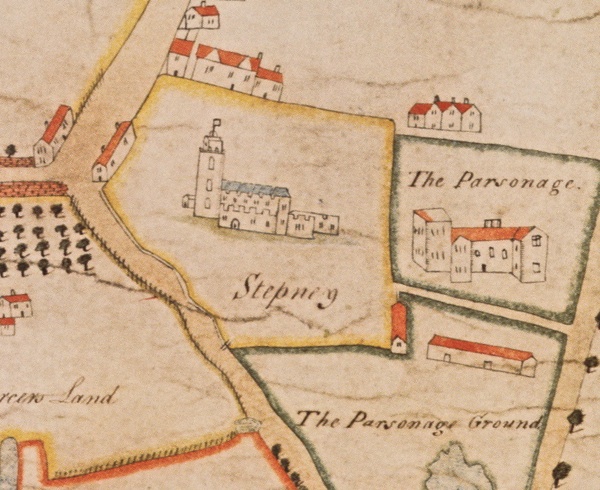I wrote recently about 8 x great grandfather Captain William Greene, mariner of Ratcliff, Stepney, who died in about 1686. William’s son was Joseph Greene, described in an inscription on the family tomb in Stepney churchyard as a ‘Citizen and Goldsmith’. Joseph’s daughter Mary married Lieutenant John Gibson, whose daughter Elizabeth married Joseph Holdsworth: they were my 5 x great grandparents.
Searching for more information about Joseph Greene, I came across the website of the Goldsmiths’ Company, which has its own library and offers to answer enquiries from family historians. I sent a query about Joseph and received the following extremely prompt and helpful reply:
Dear Mr Robb,
Thank you for your enquiry regarding your ancestor Joseph Greene. I have searched our membership records and found the following reference:
One Joseph Green, son of William, Mariner, deceased, was apprenticed to Joseph Strong, Citizen and Goldsmith on 15 June 1692 (Apprentice Book 4, page 20). He was made free on 14 April 1708, and became a Liveryman in October of that year.
He took two apprentices, Francis Roberts, in 1708 (Apprentice Book 5, page 2) and Giles Bond, in 1713 (Apprentice Book 5, page 45). We also have details of a Sun Insurance record for him, dated to 26.4.1711, which states that Joseph Green, Goldsmith, at the Golden Ball & Ring at the corner of Little Tower Hill next to the Minories in the parish of St Boltoph in Aldersgate, citizen and goldsmith, took out insurance for his house.
Ambrose Heal’s The London Goldsmiths 1200-1800 (CUP, 1935, page 163), which is based on trade cards, among other sources, lists one Joseph Green, goldsmith and pawnbroker, at the Ring and Ball, Little Tower Hill, between 1723 and 1734. I am afraid I have not been able to find a reference to him in A.G. Grimwade’s The London goldsmiths 1697-1837 their marks & lives (London, Faber & Faber, 1990, 3rd rev).
Please do not hesitate to contact us if you have any further questions.
Yours sincerely,
Eleni Bide Assistant to the Librarian
This provides us with a wealth of fascinating new information about Joseph Green(e). We already knew that he was born in 1677 and baptised at St Dunstan and All Saints, Stepney. He would have been about eleven when his father died. The information from the Goldsmiths’ Company indicates that Joseph would have been fifteen when he was apprenticed to Joseph Strong.
There is a slight discrepancy here with our existing records for Joseph. We know that his wife’s name was Mary, and although we can’t be absolutely sure about the date of their marriage (there are a number of possibilities), there is a record of a son Joseph being born to Joseph and Mary Green of Tower Hill in October 1703 and a daughter Ann (who died in infancy) in 1705. However, my understanding was that men were not allowed to marry while still apprenticed – but this might be wrong. Joseph would only have been 18 when his first child was born. His daughters Mary (my 6 x great grandmother) and Elizabeth were born in 1710 and 1711 respectively.
It seems that Joseph was able to take on an apprentice of his own soon after becoming a liveryman, and another five years later. By this time he would have been living at the address given in the records, at the corner of Little Tower Hill and the Minories, where he appears to have remained for the rest of his life (Joseph died in 1737 at the age of 60). All of his children, and some of his grandchildren, were born at Tower Hill, though his granddaughter Elizabeth Gibson (my 5 x great grandmother) was born in the Minories: which may, in fact, be the same address.
I’ve searched in vain to find a house or property named either the Golden Ball and Ring, or the Ring and Ball. However, a newspaper advertisement from 1725 for one ‘W.Rayner, surgeon’ states that he resides ‘at the Blue Posts in Preston’s-Yard, the lower end of the Minories, the name Rayner and golden Ball hanging over the gate, near Little Tower Hill.’ This suggests that a golden ball and ring might have been simply a sign to identify a property, rather like modern house names or numbers.



There a couple of National Archives Chancery Cases that relates to Joseph GREEN goldsmith as follows:-
C 11/863/81
Widget v Browne. Bill only. Plaintiffs: George Widgit, William Hill, Robert King, Francis Coates, John Letherington, Henry Pearson, James Reynolds, William Gaskin and John Moxon, all masters and mariners of Whitby, Yorkshire, Joseph Green, goldsmith of London, Martha Smith, spinster of London (sister and administratrix of Cuthbert Smith, deceased). 1737
C 11/1148/13
Green v Goostrey. Bill only. Plaintiffs: Joseph Green, goldsmith of Tower Hill, London. Defendants: John Goostrey, Thomas Hale and Samuel Desanthum. Date of bill (or first document): 1736
Thank you, Marcus, that’s very helpful. These cases date from the final year of Joseph Greene’s life. The mention of masters and mariners of Whitby is interesting given that (a) Joseph’s father William was a mariner and (b) his son-in-law John Gibson was a coal factor and lighterman, presumably trading with the northern ports. I’ve also begun to speculate that Gibson might have come originally from Newcastle. I’m not sure how you manage to find these cases: my own searches at the National Archives tend to produce very little, so I’m obviously doing something wrong. Martin.